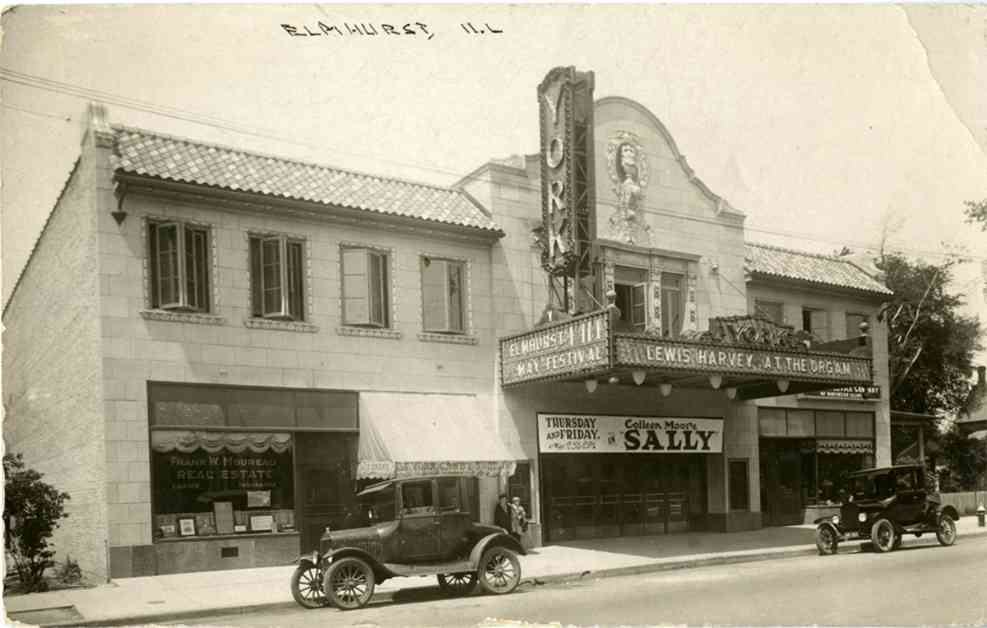The idyllic Main Street is a classic image of American ephemera. Before expressways and Cybertrucks changed landscapes, these stretches of early suburbanization forged hubs for commerce, character, and community. In Chicagoland, the remains of this Rockwellian Americana can still be found punctuating Metra stops—but of course, the times, they are a-changin’, and the character and history of suburban downtowns has evolved, for better (new crops of high-density housing along commuter lines) or worse (the presence of small businesses increasingly overtaken by Lululemons and Starbucks).
Travel west of Chicago, though, and there are a few places that have withstood time: movie theaters. In fact, Oak Park’s Lake Theatre, Downers Grove’s Tivoli Theatre, and Elmhurst’s York Theatre are three of the oldest operating cinemas in the Chicagoland region, and they have a total of 284 years in operation between them. The York—the oldest of these three—celebrates its 100th anniversary this year.
To commemorate this history, the Elmhurst History Museum presents the exhibition “Chicagoland Movie Palaces: A Century of Follies and Film,” on display now through January 5, 2025. The exhibition is a foundational history of movie theaters, from their origins as vaudeville theaters and playhouses up to the current state of theatrical exhibition, including nods to the success of “Barbenheimer” and the role of streaming. While the advertised focus and timeliness refer to the legacy of suburban movie palaces, the exhibit’s content is broader in scope, particularly as it progresses later into movie theater history. Archival objects on display include ornamental features of historic movie palaces, promotional film materials including lobby cards, and a mix of historical and contemporary photos of regional theaters, including some of Chicago’s most prolific, still-standing palaces (like the Chicago, Avalon Regal, and Music Box theaters) and some of the lesser-known cinemas that once operated in the region.
Though the central display focuses on the theaters themselves, the exhibit also features information about film production. Tactile learners will particularly enjoy the interactive self-initiated activity in which attendees can learn how foley artists create sound for a film using props and household items to reproduce noises like footsteps, closing doors, and the clacking of a trotting horse.
Nearly every town on the Union Pacific West Metra line that takes you right to the heart of Elmhurst (within walking distance of both the museum and the York) was once home to at least one movie theater. Though the marquees no longer shine through these various downtowns, many of their facades still stand, and longtime residents may still have memories of weekends watching movies at the Geneva Theatre, the Wheaton Grand Theatre (which is still in restoration limbo), or the DuPage Theatre (the source of a contentious lost battle for preservation). Such memories drove the Johnsons to expand their theater operations business after restoring the Tivoli in 1978. Shirley, who passed earlier this year, just months after her husband, recalls in one of the video interviews her memories of taking the bus to go see movies at the York. For her, the movies were a special way “to escape from our everyday life.”
If you visit the York, it is evident that the historic palace prefers to look toward the future. The cinema was built as a single-screen theater with a capacity of 1,100, but today the York boasts ten screens outfitted with luxury heated seating, 4K projection, and surround sound, sharing the same slate of first-run movies as Classic Cinemas’ 15 other locations in Illinois and Wisconsin. For those interested in learning more about local movie theater history, the Elmhurst History Museum will offer a Classic Cinemas Bus Tour that will visit the Lake, Tivoli, and York theaters on October 21. (Registration is full, but a wait list is available.) Other events supplementing the exhibition include a gallery talk; lectures on Chicago’s role in film production, the holidays on film, and the depiction of Native people in media; and trivia and screenings at the York Theatre and other local businesses.
Willis and Shirley’s son, Chris, may now have taken the reins of Classic Cinemas, but he speaks in his interview about his own fond memories of the movies and how film bridges entertainment and emotion. While the exhibit may not provide many fresh insights for die-hard movie lovers, it embraces local history and reminds attendees of the universality of watching movies. As you exit the gallery, you’re encouraged to add a sticky note with the title of your favorite movie. Answers range from classics like The Godfather (1972) and Casablanca (1942) to more obscure titles like Elephant Walk (1954) and Butterflies Are Free (1972). One note named Children of Men (2006), accompanied by a hauntingly out-of-place smiley face. Of course, Chicago’s classics are represented too. One person made sure to write out that their favorite film is “Blues Brothers 1980 @ York Theatre.”
That sticky note is a reminder of a town’s persisting memories. “Chicagoland Movie Palaces” recognizes cinema’s role in suspending memory between light and celluloid, from the everyday arrival of a train to one’s current favorite film. Whether you spend an hour or so at the exhibit or take the Metra for a self-guided tour of these historic cinemas and the towns that surround them, there’s plenty out in the west suburbs to appreciate for anyone with a memory of their favorite movie at their favorite theater. The streets of Elmhurst may have changed, but the movies are still there.


